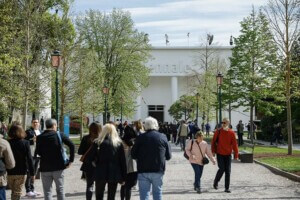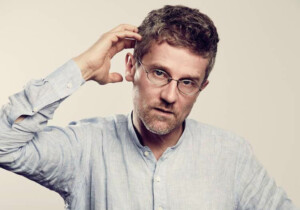From the abandoned foundations of the ill-fated Chicago Spire to the ghosts of would-be Tribune Towers galore, Chicago’s unbuilt legacy could rival the iconic skyline it actually achieved. An exhibition on display downtown, dubbed City Works: Provocations for Chicago’s Urban Future, confronts the city with its alternative skyline in the form of a panoramic wall design and a “Phantom Chicago” iPhone app. The overall effect evokes “a dream but also a nightmare,” in the words of curator Alexander Eisenschmidt.
It also presents “a series of urban environments that are typical for Chicago,” meditating through the work of four prominent local designers on some of the city’s contemporary challenges: waterways, industry, shelter, and vacancy. To borrow Eisenschmidt’s metaphor, the aim is to turn potential nightmares into visionary dreams.
Studio Gang’s work on urban waterways is well-known and their work here, titled “Reclaiming the Edge,” reprises the vision they laid out in Reverse Effect and other publications: a riverfront community and restored natural habitat nourish each other in a kind of urban symbiosis. After years of legal wrangling, Chicago’s Water Reclamation District will soon disinfect the wastewater it dumps back into the river, signaling some substantive progress on water quality. Meanwhile the Chicago Riverwalk grows along the waterway’s main branch.
UrbanLab / Sarah Dunn & Martin Felsen present “Free Water District,” a vision that also draws on Chicago’s aquatic resources. Rust Belt cities share many challenges stemming from deindustrialization, but they also share a common asset: water. UrbanLab’s piece envisions a Great Lakes region revitalized by water-focused industries, in a “megastructure-scaled public/private land/water partnership.”
Stanley Tigerman offers a rumination on shelter in both the spatial and spiritual sense with “Displacement of the Gridiron with the Cloister.” His target is the “ineffable in architecture,” which is philosophical enough to mean many things to many people who might have very different ideas of the city’s urban aspirations.
“The Available City” by David Brown displays a similar yearning, manifesting the city’s 15,000 city-owned vacant lots as blots of color bubbling up amid fractured neighborhoods. The bright colors, which appear to denote potential programs for unused space, could mean anything — adaptive reuse, public space, space-age capsule hotel — but the important thing is they reanimate dead spaces that total an area twice the size of the Loop.
All four panoramas will eventually connect, sharing continuous topographic or development features. But until the closing days of the show they remain separate, traveling slowly along dotted lines that traverse the small exhibition space. “By pulling them apart,” Eisenschmidt said, “there’s a little suspense.”
City Works, adapted from the 2013 Biennale in Venice, returned to its city of origin May 24. And these “provocations” are not Eisenschmidt’s first. In 2011 the University of Illinois at Chicago professor’s Visionary Chicago (reviewed here for A|N by Philip Berger) stirred conversation about bold building while the real estate market languished.
The free show is open at Expo 72, 72 E. Randolph St., seven days per week through September 29.
Listen to a conference on the topic, held September 22, 2012 and recorded by WBEZ. Watch 50 meters of the “Phantom Chicago” wall panorama scroll by:










